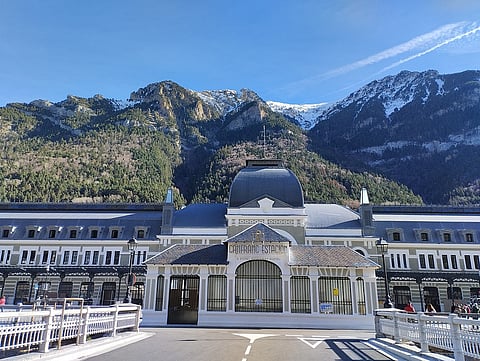
- Destinations
- Experiences
- Stay
- What's new
- Celebrating People
- Responsible Tourism
- CampaignsCampaigns
- SubscribeSubscribe
- Buy Now

Across Europe, historic buildings like old banks and department stores are being revived through adaptive reuse—the practice of transforming existing structures for new purposes. Many are now hotels, blending original architecture with modern amenities to create unique stays that connect past and present. Nicknamed the “Titanic of the Mountains,” an ill-fated train station at Canfranc in Northern Spain is getting a new lease as a five-star hotel. Once a symbol of ambition and misfortune, the vast Beaux-Arts structure in the Spanish Pyrenees is now poised for revival—nearly a century after its grand opening.
The Canfranc Estación, a Royal Hideaway Hotel, is a five-star luxury property housed within the historic Canfranc International Railway Station — a striking Beaux-Arts landmark tucked into the Aragonese Pyrenees in northern Spain. The station has been meticulously restored by the Barceló Group, transforming it from decades of abandonment into an opulent destination.
The hotel features 104 rooms and suites, a spa and wellness centre with a heated indoor pool, a gym, and three restaurants, including a Michelin-starred venue that serves contemporary Aragonese cuisine inside a restored railway carriage. An Art Deco-inspired bar adds to the atmosphere of vintage glamour.
Careful attention has been paid to preserving the station’s original character. The former ticketing hall now serves as a grand vaulted lobby, and staff wear custom 1920s-style uniforms that nod to the building’s golden age of rail travel. Guests enter the hotel from the Spanish side of the historic station, where they are welcomed at a walnut check-in desk beneath a large station clock and the Spanish coat of arms. On the opposite end of the building, the French coat of arms still adorns the wall — a nod to the station’s origins as a joint venture between Spain and France.
Opened in 1928, Canfranc International Station was envisioned as a grand link between Spain and France—an architectural marvel with 365 windows and 156 doors, symbolising cross-border unity. Its scale and design reflected lofty international ambitions, and its opening was attended by both Spanish King Alfonso XIII and French President Gaston Doumergue. But the station’s history quickly turned turbulent.
The station was damaged by fire, disrupted during the Spanish Civil War, and became a hub of covert activity during World War II, including the smuggling of refugees and rumoured Nazi gold dealings. Despite intermittent use, tragedy struck in 1970 when a derailment on the French side destroyed a key bridge, severing the international line and leaving the station abandoned for decades.
Adaptive reuse of old buildings is often celebrated for preserving architectural character and cultural heritage while giving these spaces new life—as hotels, residences, or cultural venues. This approach is also more sustainable than demolition and new construction, reducing waste and conserving resources. Notable examples include a former bank in Prague turned into a luxury hotel with a rooftop bar, and London’s Old War Office, reopened in 2023 as The OWO, a high-end hotel and residences.
However, this transformation can deepen social divides. Take the historic mills of Bombay (Mumbai), for example. Once bustling centres of work for thousands of lower-income laborers, the closure of these mills caused widespread loss of livelihoods. Today, many of these same spaces have been repurposed into upscale malls, restaurants, and commercial complexes catering primarily to wealthier clientele. This stark shift—from working-class workplaces to luxury venues—highlights the irony and potential disenfranchisement tied to adaptive reuse projects, which can prioritize exclusivity over community heritage and access.
To reach Canfranc from Spain, take the daily Renfe Media Distancia train from Zaragoza directly to Canfranc. From France, travel by TER train from Pau to Bedous, then transfer to a connecting TER bus for the final leg to Canfranc. Driving is also possible via the E-7 road through Jaca. Alternatively, you can fly into a nearby airport and combine train and bus travel to reach the station.
From France, you can take a regional train from Pau to Bedous. At Bedous station (Gare), you’ll connect to a TER bus that continues on to Canfranc. Alternatively, driving is an option, with routes passing through towns like Pau or Lourdes.
Winter offers stunning snow-covered mountains and excellent skiing opportunities, while summer is ideal for hiking. For a quieter experience and better rates, consider visiting during the shoulder seasons of spring and autumn.
In Canfranc, Spain, visitors can explore a rich blend of history, architecture, and nature. The monumental Canfranc International Train Station stands as an impressive symbol of the region’s international heritage, with its unique Spanish and French sides. Nearby, the Parish Church of La Asunción captivates with its three stunning Baroque altarpieces, while the 12th-century Torre Palacín de Aznar offers a glimpse into medieval architecture. The Pilgrims’ Bridge, spanning the Aragon River, is another notable landmark steeped in local history.
For outdoor enthusiasts, hiking trails wind through surrounding valleys and mountains, leading to scenic spots like the Ibón de Piedrafita and the atmospheric ruins of the Hospital of Santa Cristina. After a day of exploration, visitors can savor traditional cuisine that reflects both Spanish and French influences, completing a well-rounded cultural experience.
Q1: Where is Canfranc International Station located?
It is located in the Aragonese Pyrenees, in northern Spain near the French border.
Q2: Why is Canfranc Station called “Europe’s unluckiest train station”?
Nicknamed the “Titanic of the Mountains,” the station faced accidents, war, smuggling, and eventual closure, earning its unlucky reputation.
Q3: What is Canfranc Station now?
It has been transformed into a five-star luxury hotel by the Barceló Group, called Canfranc Estación, a Royal Hideaway Hotel.
Q4: What architectural style is Canfranc Station built in?
It is a Beaux-Arts masterpiece, featuring grand facades and ornate details reminiscent of early 20th-century European architecture.
Q5: Can travelers still take trains from Canfranc?
Yes, the station continues to serve as a rail hub, alongside the new luxury hotel accommodations.
